Guide To General Safety
May 02, 2019 at 2:16 PM
GUIDE TO GENERAL SAFETY
Jump To:
Driver Safety - Start Before You Get Behind The Wheel
5 Commonly Misunderstood Road Rules.
Driving Lessons Are Essential For The Safe Driver
10 Questions To Ask Your Driving Instructor
The Safe System Approach To Driving.
Drinking And Driving.
Older Drivers - What You Need To Consider
Checklist For A Safe Driver
What Kind Of Driver Are You?
Driver Safety - Start Before You Get Behind The Wheel
Driving is not so much about getting to a destination, but getting there safely.
This is why so much emphasis is put on driver training and ensuring that all licence holders are capable of maintaining safety on the roads. It is for this reason that drivers should start learning practical aspects of driving even before they get behind the wheel.
There are several reasons why this is necessary for all aspiring drivers. We will discuss some of these to emphasize the importance of an early start on driving lessons.
So why should you start learning the practical aspects of driving before getting behind the wheel?
Let’s not get ahead of ourselves here. Let’s first discuss the ‘how’: how do you learn practical aspects of driving without getting behind the wheel?
Well, it’s easy, probably the easiest thing during the entire driver training period. You just need to be in the company of an experienced driver, watch him/ her drive and ask questions where you need explanation.
Now to the why.
This “pre-training” will give you an edge when it’s time to actually get behind the wheel. It helps you:
- Understand the different gadgets in a car and their purpose. A car driver uses several gadgets when driving. Seeing them being used by a licenced driver on the road will help you get an idea of how they work and the purpose they serve.
- Build Confidence. By the time you are getting behind the wheel, you will already be acquainted with cars. It will not feel too awkward which is good for your confidence. The more confident you are, the less prone you are to making mistakes when you are behind the wheel
- Get an early grasp on safe driving. Learning from a qualified driver who has already had a few years’ experience will help you get the fundamentals of safe driving. You will be able to see the kind of following distance that is safe, how to turn corners, and even how to overtake in real life situations.
- Traffic codes and laws. Learning before you get behind the wheel helps you understand the different traffic codes and laws. It will help you stay out of trouble when you actually get behind the wheel. Seeing rules being observed by someone else also makes them less forgettable in the long run.
- Reduced training time on basics. Time is money. Driving lessons are charged by the hour – that is if you choose to hire the services of a driver training professional. The less time you spend learning the basics, the better. Learning the practical aspects before you can drive will ensure that you can move on to the more advanced lessons as quickly as possible.
Most aspiring drivers assume that it is only by getting behind the wheel that they can learn how to drive. But that is not the case, learning should start much earlier.
Starting earlier will give you an upper hand when the actual lessons start. It’s like reading ahead of the teacher, only more fun.
5 Commonly Misunderstood Road Rules
- Indication when going straight ahead (taking the second exit) on a roundabout.
From: http://www.nzta.govt.nz/resources/roadcode/about-driving/giving-way-at-roundabouts.html
If you are going 'straight' through a roundabout:-
- don't signal as you come up to the roundabout, or
- signal left as you pass the exit before the one you wish to take. At some small roundabouts it may not be possible to give three seconds warning, but it is courteous to give as much indication as you can.
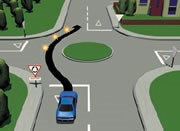
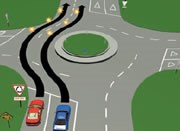
-
- Give way rules when approaching a cross intersection controlled by a Give Way or Stop sign.
From: http://www.nzta.govt.nz/resources/roadcode/about-driving/the-give-way-rules.html
When both vehicles are facing the same control, such as Stop signs, Give Way signs and green traffic signals, apply the rule "straight before turning".
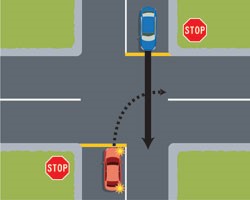
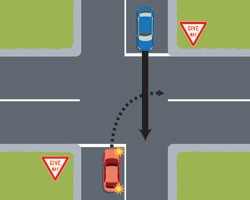
-
Following distance rules.
From: http://www.nzta.govt.nz/resources/roadcode/about-driving/following-distance.html
Keeping a safe following distance
A good way to make sure you always keep a safe following distance is to use the two-second rule or the four-second rule, which are explained below.
The two-second rule
Under normal conditions, the two-second rule is an easy way to make sure you have allowed enough following distance between your vehicle and the vehicle in front, no matter what speed you're travelling at.
To check if you are travelling two seconds behind the vehicle in front:
The four-second rule- watch the vehicle in front of you pass a landmark – such as a sign, tree or power pole – at the side of the road as it passes the landmark, start counting 'one thousand and one, one thousand and two'
- if you pass the landmark before you finish saying those eight words, you are following too closely - slow down, pick another landmark and repeat the words to make sure you have increased your following distance.
In bad weather, when the road is wet or slippery, or when you're towing a trailer, you need to increase your following distance to four seconds, because you'll take longer to stop if you need to.
To check that you are travelling four seconds behind the vehicle in front, follow the instructions above for the two second rule, but count 'one thousand and one, one thousand and two, one thousand and three, one thousand and four' instead. - Using Flush Medians.
From: http://www.nzta.govt.nz/resources/roadcode/about-driving/turning.html
Turning on or off a road with a flush median
A flush median is a strip in the centre of the road that is marked with white diagonal lines within parallel lines. It provides a place for vehicles that are turning right, or vehicles that have turned right onto the road from a side road or driveway.
You can only drive onto the flush median to:
- wait to move into a gap in the traffic flow after you have turned right (car A in the diagram below)
- slow down and wait before turning right (car B in the diagram below)
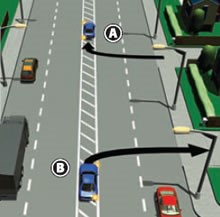
- Stopping at intersections.
From: http://www.nzta.govt.nz/resources/roadcode/about-driving/stopping-at-intersections-etc.html
You must not go into or attempt to cross the intersection, railway level crossing, pedestrian crossing or an area controlled by pedestrian traffic signals, unless there is space for your vehicle on the other side of the intersection or crossing.
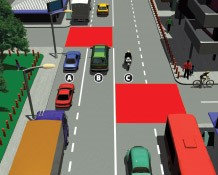
Driving Lessons Are Essential For The Safe Driver
Safety on the road is not the responsibility of some of us, but that of all of us. To eliminate injuries and death due to road accidents, it will take the collective efforts of all road users. This includes you; the driver. It is thus in the interest of everyone that all drivers get the right quality of skills before they are allowed on our roads.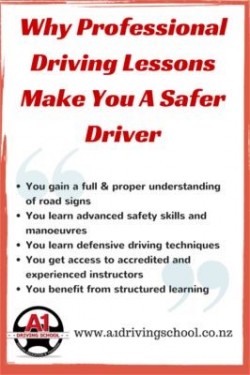
Training is a crucial component in the development of a safe driver. Professional driver training for all would-be drivers is recommended to ensure that the proper skills are imparted to the learner.
Reasons why professional driving lessons make for safer drivers:
- Proper understanding of road signs – The ability to interpret and understand road signs is one the most important skills a driver should have. Road signs are meant to protect you and other road drivers. A professional trainer will teach you the meaning of different road signs to ensure that you and others on the road are safe at all times.
- Safety skills and manoeuvres – a professional driver instructor will be able to teach you safety manoeuvres and skills you can use in case of an emergency to avoid accidents.
- Defensive driving techniques - Driving schools provide sessions on defensive driving. This provides the driver with hands-on experience by practising with simulated road situations. This enables the student to learn how to react in real time in a split of a second making sure that everyone is safe.
- Skills upgrade – Professional trainers offer courses for drivers who want to operate specific types of vehicles such as trucks. This helps the driver gain knowledge and experience in operating the vehicle reducing the risk of on-the-site accidents significantly.
- Lessons are taught by accredited professional instructors – Professional driving instructors are accredited by the NZTA. This means that these trainers have undergone the necessary amount of training that is required for proper provision of driver education.
- Use of structured learning programs – This ensures that the trainer touches on all the important stuff that a new driver needs to learn for them to be safe on the road.
- The trainers experience - Professional driving instructors possess invaluable road safety experience that is passed on to the driving student. This further enhances the safety of the driver.
- Availability of the proper teaching tools - A driving school will have all the proper teaching tools to teach new drivers. Learning with the right teaching tools enhances the competence of a learner making him more aware on the road.
- Adequate hands on experience for students – Professional driving instructors make sure that the driving course is long enough so that the driver gets the minimum hours of on-road driving experience. The more the hours of experience, the safer the driver will be.
- Increased driver confidence – professionals are able to build the learners confidence through adequate training and supervision. Confident drivers make for safe drivers.
Acquiring driving skills from a professional ensures that you get the necessary training on road safety for yourself and others.
10 Questions To Ask Your Driving Instructor
Learning to drive can be stressful and expensive; and there are numerous driving instructors all fighting for your business. So how do you choose the right driving instructor?
Here are 10 questions to ask your driving instructor before you pay them any money:
- Are you a fully qualified driving instructor and how long have you been an instructor?
Generally, there are two types of driving instructors, fully qualified and trainee driving instructors. A trainee driving instructor is not necessarily bad but will not have passed all exams and thus has limited experience. A good driving instructor must have at least two to three years-experience behind them as it does take a driving instructor some time to become established with their instructing techniques and to become confident about which technique works best for certain individuals. - Are you skilled with the driving test routes in this area?
It is not only vital to find an instructor with some few years of experience, but experience in your routes as well. Driving test roads are arranged by the local test examiners and often have some of the most difficult routes and traffic systems within the set perimeter of the exam centre. A reputable instructor who understands these difficult roads will provide you with adequate practice, leaving no surprises when it comes to taking your driving test. - Will I have the same instructor for each driving session?
This is important as a driving instructor who has been teaching you will understand your capabilities and precisely where you are in terms of progress. Different trainers will have to evaluate your progress `and will need to get used to the best way of instructing you. In addition, it will take you some time to get a good understanding of a different trainer’s teaching methods. - Will I have the same vehicle for each session and the driving test?
Several driving instructors use reference markers, particularly when it comes to movements, such as the reverse round a corner, turn in the road etc. A good number of the reference markers can be car specific, thus learning in various cars will require familiarizing with the reference markers. All of which takes additional time. - What is your pass rate?
Try to look for a driving instructor or school with a high test pass rate. - How much do you charge for your driving lessons?
Choosing the cheapest driving school that you can find is generally a bad idea. A driving instructor or school offering driving lessons well below the local average is probably struggling for work or is new to the area. If the driving school is new to the area, it may be likely that they are not familiar with the roads. - Do you offer driving lessons discounts?
Many driving instructors offer either block booking discounts or student discounts. In order to get a block booking discounts, a pre-paid amount of driving lessons is usually required. - How long do your driving lessons take?
It’s important to make sure that lesson lasts for the whole-time duration stated. - Is there any car sharing involved?
Reputable driving schools offer only one-on-one tuition. Sometimes a driving instructor or school may use a certain degree of car sharing. - Can you pick me up from a different location?
Most reputable driving instructors offer this service. It can be very beneficial for you if you can be picked-up from a different location, such as a friend’s place, school or workplace.
The Safe System Approach To Driving
Originally developed in Sweden, the safe system approach has been in use in New Zealand since 2010 and has helped reduce death and injury on our roads. Although there is still much to be done, this system has been able to reduce road accidents by a significant margin. The system tries to create a more forgiving road system that gives room for human fallibility and vulnerability, to reduce the impact of mistakes. We can all agree that mistakes are inevitable.
This system accepts that:
- People make mistakes on the road that sometimes result in accidents.
- People are fragile and will suffer from injury, sometimes losing their lives.
- Responsibility should be shared between road users and road system designers ( such as police, planners, policy makers etc).
- All components of the road system (roadsides, roads, speeds, road use and vehicles) need to be improved so that they complement each other in accident prevention.
With these conditions and considerations roads will be safer, speeds better managed, and more safety features will be incorporated into vehicles and road systems to save more lives by allowing for mistakes.
Drinking And Driving
We have heard it time and time again… “If you drink, don’t drive.” As simple as this concept is, many people continue to do it over and over again because they believe that they are “not that drunk” or that they are “safe to drive”. One drink is one drink too many and every time you get behind the wheel you risk injuring or killing another driver on the road. If you drink & drive, you can face stiff penalties even if you do not harm anyone.
If you drink & drive and you are pulled over by the police, you can be made to undergo roadside screening and depending upon the results of those tests, you may be subject to arrest, large fines, legal bills, court time, embarrassment and ultimately, job loss. You will be required to breathe into a roadside screening device which will measure your blood alcohol content. If you refuse to undergo that test then you may be obligated to provide a blood sample which will also provide the same information to police.
The next step is to be formally charged and then to proceed to court to face those charges in front of a judge. The truth is that there is no way to know exactly what penalty or charge will be imposed by the Court if you decide to drink & drive. You can be assured, however, that if you are a repeat offender that you will experience penalties that become more serious with each new offence.
Having a Blood Alcohol Content (BAC) over the legal limit can have serious consequences. Here are some of the things that may happen to you if you are charged with drinking and driving:
Penalties for drink driving offences
These are summarised on: http://www.nzta.govt.nz/resources/factsheets/55/driving-offences.html
The issue is that you will not only need to deal with the legal consequences when you drink & drive, but also with the humiliation and shame that can result from being charged with such an offence. If a person has a drinking problem, this kind of legal trouble can lead to them losing their marriage, losing access to their children, being unable to commute to work or to do other normal things that a person can do when they hold a valid driver’s licence.
If you lose your licence due to drinking and driving it can not only be inconvenient but it might cause you to have to rely on other people to help you get to where you need to go. Some people drive professionally for a living, so the loss of their licence can be devastating and can lead to the loss of their job.
The message is simple and very clear: don’t drink and drive.
Older Drivers - What You Need To Consider
As you start to get older, some of your skills will start to deteriorate. This does include your driving skill. Many other aspects will also deteriorate that will affect your driving, such as eyesight and coordination. But these are not the only things that you have to think about when you are driving at an older age. Below will detail the major considerations, and some helpful tips to keep you on the road safer for longer.
Risks Of Older Drivers
Before we talk about if you personally should be driving, we'll quickly go through why it is important to think about it. Many studies have been done about the risks different age groups pose on the road, and people above the age of 80 are the most dangerous, to themselves and others. This is because at this age your reaction time is far longer than when you were 20, and this makes it far harder to control your vehicle in an emergency situation. Also, retirees are less likely to regularly travel long distances, usually just driving to the shops or a friend's house. Because of this, you're less likely to be able to cope with long distances or high speed or heavy traffic. Another major problem is the fact that older people are generally quite frail, and will be far more at risk of serious injury or death in the case of a car crash.
What About You?
If you aren't sure if you should be driving, purely for physical reasons, visit your GP. They will be able to test you and refer you to specialists that can help you to determine what risk you pose on the road. Everyone ages differently; you could be 70 with poor motor skills, or 100 and still in great health. It's entirely up to your personal health, and your personal choice how you choose to move onwards. There are many things you can do to prolong your good health or improve it also; again ask your GP.
Insurance
As you get older, the price of insurance will start to rise. Pensioners are seen as a risk on the road by insurance companies, and as such they will up their costs. While this is a good idea in writing, it can have devastating effects on elderly people. As such, it sadly has to become a consideration in whether to continue driving or not. There are ways to counteract this though if you do wish to stay on the road. If you feel your insurance is too high, consider reapplying. Do some research about insurance packages for over 65s. Get quotes from various companies to try and find the best deal to suit you.
Driver Training
If you worry your skills aren't quite 'up to scratch', consider taking a few driving lessons. There are many driving instruction companies that offer lessons aimed at improving your reaction time and how to manipulate your skills to match the modern roads. By participating in one of these courses, you can personally assess your safety on the road, and how to improve it. This option is probably the best one (apart from visiting your GP) for deciding if you should continue driving. Partaking in regular lessons will also help you to stay on the road for longer, so contact your local driving school and organize a lesson today.
Checklist For A Safe Driver
Safe driving is an attitude and a way of thinking. It is important for every driver to think of their own safety as well as the safety of their passengers and other drivers around them each time they get behind the wheel. When a driver is alert they are a safer driver and can better avoid being involved in a collision either from their own mistakes or through the mistakes of others.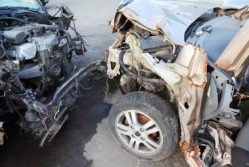
This safe driving checklist may help you to stay safe on the roads:
Following distance
For many new drivers the ability to judge the distance between their own vehicle and one in front of them has not yet been fully developed. In older drivers this skill deteriorates with age and reaction times can increase.
It is important to leave a safe distance between your own vehicle and the one you are following. A safe distance is at least two seconds in normal driving conditions, but when roads are wet or after dark it is advisable to leave at least a four second gap between vehicles.
You can judge the distance of the gap by choosing a roadside object ahead and once the car in front of you passes that object, begin counting the seconds (one thousand and one, one thousand and two) until you reach that same object.
If you reach that same object before you count two seconds then you are following too closely.
Larger gaps should be left if you are uncertain of the road ahead, the weather conditions are rainy or foggy, you feel tired or you have a heavy load in your vehicle or are towing something.
Hands Free
If you have a cellular phone, utilise a Bluetooth connection in your vehicle and make certain that you are hands free. Better still, don’t use a phone at all. In New Zealand it is illegal to hold a phone for calling or texting.
Be Cautious in Car Parks
When you are parked in a lot it can be difficult to see what is around you when you are backing out of your parking space. Look carefully around your vehicle and look in all of your mirrors as you back out.
You will need to be aware of pedestrians, children, mobility scooters and other hazards that you may not be able to see when you are backing up. If there is a passenger in your car, have them look around too.
Use Your Headlights during the Day
Most new vehicles have a standard daytime running light setting where the headlights are on during the daytime.
A safe driver will turn on headlights in vehicles that do not have daytime running lights. Headlights reduce the risk of your involvement in a crash because you will be more visible to other drivers.
Observing the Speed Limit
Speed limits that are posted are the maximum speed that you can legally drive in that particular area. Ensure you always adhere to posted speed limits.
If driving conditions are not ideal, you should drive at a lower speed that is safer for the conditions.
It is also important to not drive too slowly because this can be a serious traffic hazard for other drivers on the road.
If you tend to drive at a slower pace, check your rear view mirror and if you see a build-up of traffic behind you, pull over when it is safe to do so in order to let those vehicles pass by.
If there is more than one lane, drive in the far left lane so that other drivers can easily move around you.
In school zones it is important to observe the posted speed limit because children can often run across the street without looking for traffic.
Be careful when passing school busses and make sure to slow down to 20km/h when passing a school bus that is taking on or letting off children.
Be Aware of what is Around You
A safe driver should regularly glance in rear and side view mirrors so that they know what is beside their vehicle and what is behind it.
This is extremely important when a driver is planning to change lanes or overtake another vehicle.
Adjusting your Mirrors
Before you begin driving, you will need to adjust your mirrors and ensure that your seat is in a comfortable position. The mirrors on the outside of the car need to be adjusted so that you can see the edge of your car and the road beside it.
When you adjust your outside mirrors you should see the area above the rear door handle in the bottom corner of your side mirror.
Even if your mirrors are adjusted perfectly, you will still have blind spots and these can only be dealt with by turning your head and conducting a head check.
A safe driver will view all mirrors regularly as they are driving so that they are aware of what is going on around them.
Approaching an Intersection
When you approach an intersection slow down if there are give way signs or a stop sign. If the intersection has no signs, use the give way rules. If there are no vehicles, slow down, stop and then proceed when clear.
It is never a good idea to continue into an intersection without stopping to take a look around. Other drivers can approach the same intersection without slowing down and drive right through.
The only time it is alright to continue through an intersection without stopping is if the light is green. If the light has just turned green, proceed with caution because drivers coming from opposite directions may be running the red light.
Merging
When you are entering onto a motorway or a road narrows from two lanes into one, you will need to merge. It can be difficult to see the traffic behind you when you are trying to merge, so have a good look at the traffic as you merge up the lane and look for any gaps that you can merge into.
Turn on your indicator to let the driver that is behind you know that you are going to merge and then make your move.
If you wait too long the driver behind you may close up the gap. Adjust your speed to match the speed of the traffic and then merge in. Try to give a friendly wave once you have merged to thank the driver behind you for letting you merge in.
Have a Clear View
The mirrors on your vehicle do not always show everything that is around you. Blind spots will prevent you from seeing smaller vehicles like bicycles or motorcycles. Always do a head check by turning your head to look before pulling into a road.
Driving at Night
If you plan to drive long distances or at night, pull over and rest if you feel tired. Falling asleep at the wheel can result in a fatal crash. Simple.
Advanced driver training can really assist with your safety on the roads, and those around you.
Make sure the vehicle you drive is in good working order and is regularly serviced. Check to make sure your lights are all working correctly especially when driving at night.
A basic vehicle check should include a walk around the vehicle to make sure no one has driven into your vehicle while it was parked and there is no obvious damage.
Do a visual check of the tyres and make sure the Warrant of Fitness and Registration are current.
What Kind Of Driver Are You?
Take a look at the infographic below to determine what kind of driver you are:
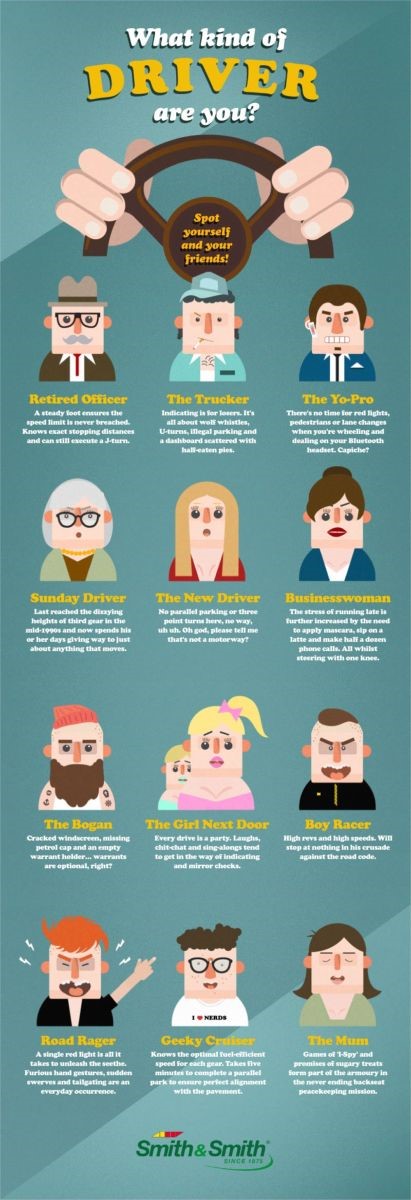



 BOOK NOW
BOOK NOW
